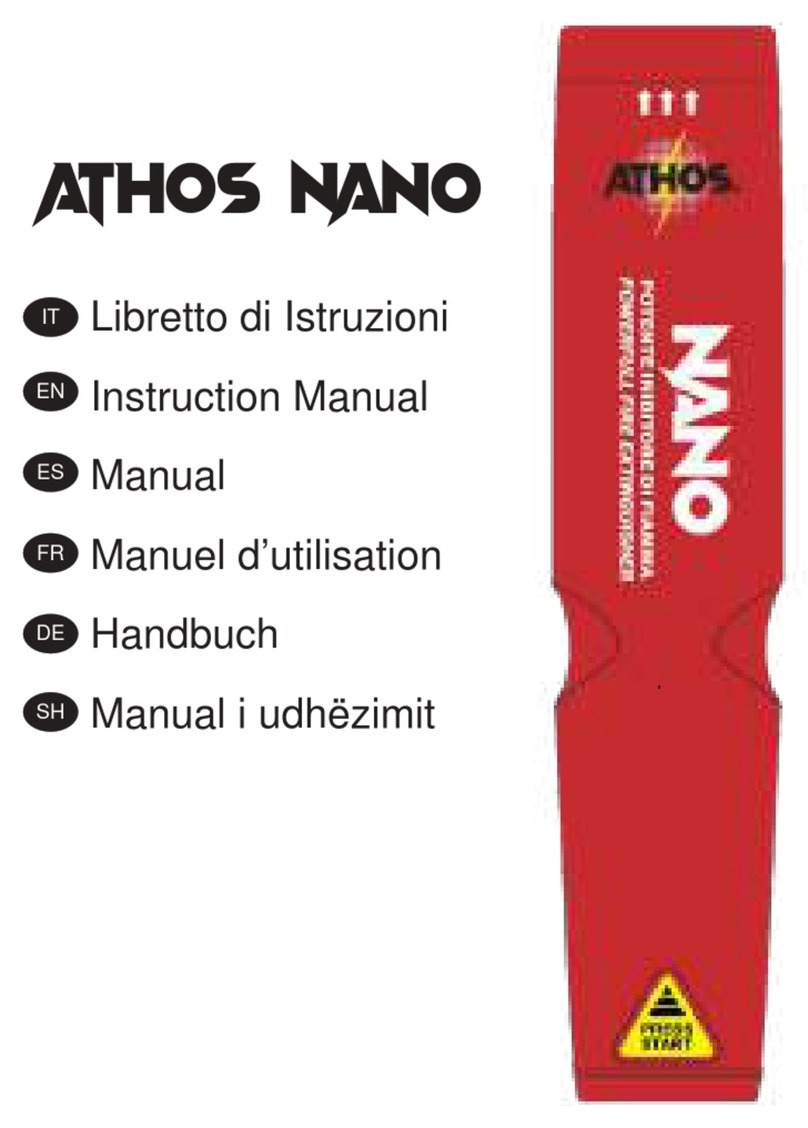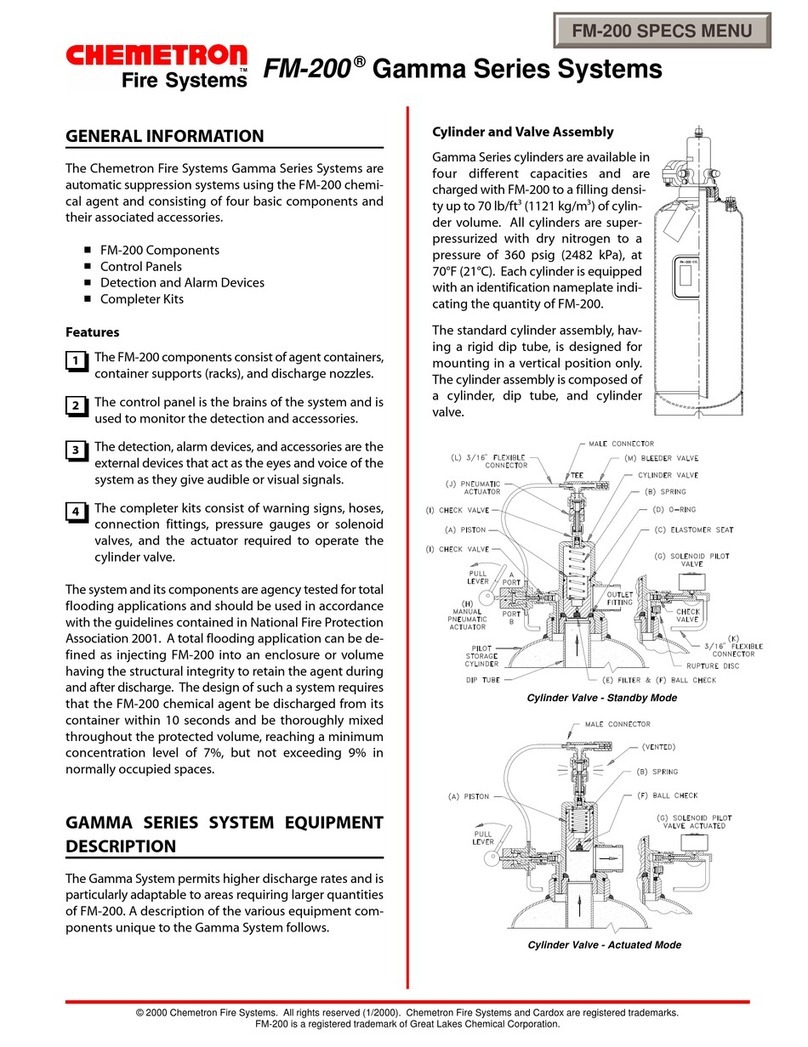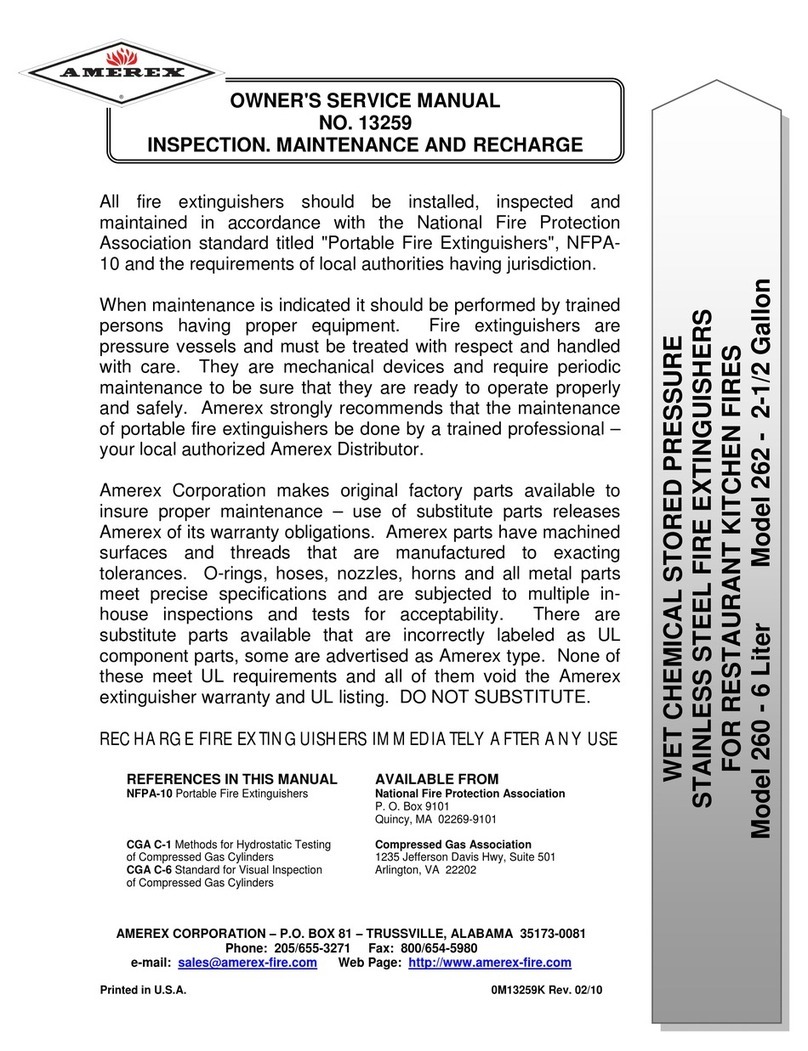STRIKE FIRST SF-PW250 User manual

1
SERVICE MANUAL (v1)
UL / ULC
WATER – HAND PORTABLE
STORED PRESSURE FIRE EXTINGUISHERS
Model: SF-PW250 / WBDL-PW250
All fire extinguishers should be installed, inspected & maintained in accordance with the National Fire Protection Association (NFPA) 10,
2007 Edition “Standard for Portable Fire Extinguishers” and the local authorities having jurisdiction.
When installation, inspection or maintenance is required, Strike First Corporation strongly recommends the work to be performed by
NFPA 10 (2007) certified personnel. Fire extinguishers are pressure vessels and must be treated with respect and handled with care.
They are mechanical devices and require periodic maintenance to be sure that they are ready to operate properly and safely.
Strike First Corporation makes O.E.M. parts available to insure proper maintenance. Substituting O.E.M. parts voids the Strike First
warranty, as well as the UL & ULC Listings. DO NOT SUBSTITUTE.
Strike First Corporation does not service, maintain or recharge fire extinguishers. This manual is published as a guide to assist qualified
service personnel in the inspection, maintenance and recharge of Strike First fire extinguishers only. This service manual should be
used in conjunction with the appropriate Parts Lists/Pictograms for each unit being serviced. No service manual can anticipate
all the possible malfunctions that may be encountered in the service of fire extinguishers. Due to the possibility that prior service
performed on this equipment may have been improperly done, it is extremely important that all warnings, cautions and notes in this
manual be carefully observed. Failure to heed these instructions could result in serious injury.
Strike First Corporation assumes no liability for service, maintenance or recharge of fire extinguishers by publishing this service manual.
For installation instructions of Strike First portable fire extinguishers please refer to all of the following:
1. Owner’s Manual - included with the unit
2. NFPA 10 “Standard for Portable Fire Extinguishers – 2007 Edition
3. Local authorities having jurisdiction
For operation instructions on Strike First portable fire extinguishers please refer to one or all of the following:
1. Fire Extinguisher Nameplate/Label
2. Owner’s Manual – included with the unit
3. NFPA 10 “Standard for Portable Fire Extinguishers – 2007 Edition
4. Your local authorized Strike First Distributor
WARNING: ALWAYS WEAR EYE PROTECTION WHEN SERVICING PRESSURIZED FIRE EXTINGUSIHERS.
CAUTION: PERSONS EXPECTED TO USE THIS FIRE EXTINGUISHER SHOULD BE TRAINED IN INITIATING ITS
OPERATION AND IN THE PROPER FIRE FIGHTING TECHNIQUE.
RECHARGE FIRE EXTINGUISHERS IMMEDIATELY AFTER ANY USE
H2O
STRIKE FIRST
CORPORATIO
N
WARNING
DO NOT USE THIS EXTINGUISHER ON CLASS C (ENERGIZE ELECTRICAL EQUIPMENT),
B (FLAMMABLE LIQUIDS) OR D FIRES.
PROTECT FROM FREEZING TEMPERATURES

2
INSPECTION* (ref. 7.2 - NFPA 10, 2007)
The inspection procedures outlined below may not be sufficient for every jurisdiction or location and should be used in
conjunction with the NFPA 10 Standard for Portable Fire Extinguishers, 2007 Edition.
Fire extinguishers shall be manually inspected when initially placed in service. The inspection is intended to give reasonable
assurance that the extinguisher is fully charged and operable. This is done by seeing that it is in its designated place, has not
been actuated or tampered with, and there is no obvious physical damage or condition to prevent operation.
WARNING: FOR SAFETY PURPOSES, IF AN EXTINGUISHER SHOWS SIGNS OF CORROSION OR MECHANICAL
DAMAGE, IT SHALL BE SUBJECTED TO A HYDROSTATIC PRESSURE TEST OR REPLACED.
PERIODIC INSPECTION PROCEDURE
(Monthly or more often if circumstances dictate)
Periodic inspection of the fire extinguisher shall include a check of at least the following items:
1. Location in designated place
2. No obstruction to access or visibility
3. Fullness determined by weighing or hefting
4. Seal and tamper indicators not broken or missing
5. Operating instructions on nameplate are legible and facing outward
6. Examine for obvious physical damage, corrosion, leakage, or clogged hose and/or nozzle.
7. Pressure gauge is in the “green” operable area.
MAINTENANCE (ref. 7.2 & 7.3 - NFPA 10, 2007)
Maintenance, servicing & recharging shall be performed by trained and certified persons having available the appropriate
servicing manual, the proper types of tools, recharge materials, lubricants, and Strike First O.E.M. replacement parts.
Fire extinguishers shall be subjected to maintenance at intervals of not more than 1 year, at the time of hydrostatic test, or when
specifically indicated by an inspection. Extinguishers taken out of service for maintenance or recharge shall be replaced by spare
extinguishers of the same type and at least an equal rating.
MAINTENANCE PROCEDURE
1. Clean extinguisher to remove dirt, grease or foreign material. Avoid the use of solvents around the pressure gauge.
This could damage the plastic face. Check to make sure that the instruction nameplate and UL/ULC manifest are
securely fastened and legible. Inspect the cylinder for corrosion, abrasion and dents. If any of these conditions are
found or you doubt the integrity of the cylinder, hydrostatically test to factory test pressure, using the proof pressure
method and a suitable cage, in accordance with CGA Pamphlet C-1 and The National Fire Protection Association
(NFPA) Pamphlet No. 10 “Standard for Portable Fire Extinguishers” 2007 Edition.
2. Inspect the extinguisher and replace any parts that are damaged, missing, corroded or O.E.M. substitute parts. Only
factory O.E.M. replacement parts are approved for use on Strike First fire extinguishers.
3. Weigh the extinguisher. Extinguisher weight MUST fall within the + / - tolerance of the total charged weight limits in the
“MAINTENANCE” section on the label. Any extinguisher not falling within the tolerance limits shall be properly
recharged.
4. Check the date of manufacture stamped on the hanger loop or the date of last hydrostatic test on the label affixed to the
extinguisher. Cylinder must be hydrostatically tested every 5 years to test the pressure indicated on the nameplate.
Recharge with fresh potable drinking water after hydrostatic test.
5. Inspect the pressure gauge for damage. Depressurize and replace if necessary. If the pressure gauge indicator is
below the green “RECHARGE” it may indicate a leak or discharge. If the pressure indicator is above the green
“OVERCHARGED” it may indicate a faulty gauge or excess nitrogen or air. In both cases, depressurize and follow the
recharge instructions.
6. Check pull (locking) pin for freedom of movement. Replace if bent or if removal appears difficult.
7. Check the discharge lever and rivets for freedom of movement. Inspect carrying handle and rivets for proper
installation. If either is damaged, replace with OEM Strike First parts.
8. Remove hose assembly and inspect valve body interior for damage. Replace the hose if cut or cracked, or if threaded
couplings are damaged. Blow air through the hose and nozzle assemblies using air or nitrogen at 50 psi (345 kPa) or
less to insure that the passage is clear of foreign material.
9. Inspect valve assembly for corrosion or damage. Valve removal and / or valve part replacement should be made only
after completely discharging the contents of the cylinder.
10. Reinstall hose assembly into the valve body. Hand tighten only.
11. Install new tamper seal and record service data on the extinguisher inspection tag.
12. Install the extinguisher on the wall hanger bracket in its proper location. Check for correct fit – replace bracket if
necessary.

3
RECHARGING PROCEDURE
RECHARGING [NFPA 10, 7.4, 2007] IS THE REPLACEMENT OF THE EXTINGUISHING AGENT AND EXPELLANT FOR THIS
TYPE OF EXTINGUISHER.
1. Discharge all remaining pressure and water, making sure there is no remaining pressure. Do not reuse or top off water.
2. Remove the valve assembly from the cylinder. Unscrew the spring retainer, using a wrench, from the valve assembly
and remove the spring and valve stem assembly. Remove the collar o-ring from the valve assembly.
3. Thoroughly rinse all the parts with clean water and pat dry with a clean soft cloth. Blow air or nitrogen through the valve
assembly. Inspect the collar o-ring, valve stem and valve assembly and replace worn or damaged parts. Lubricate the
collar o-ring and the small valve stem o-ring with Parker O-Lube. Do not lubricate the Valve Stem Seal. Inspect the
siphon tube and replace is damaged.
4. Remove the fill tube. Rinse the cylinder with clean water and inspect the interior according to CGA Visual Inspection
Standard, Pamphlet C-6. Replace fill tube.
5. Recharge using fresh potable drinking water, following the instruction on the label.
6. Place a “Verification of Service” collar around the neck of the cylinder. Install the valve assembly and siphon tube to the
cylinder and align with nameplate.
a. The valve assembly collar nut should only be hand tightened to a maximum of 125 in./lb. Over tightening with
a wrench will damage the valve.
7. Fasten the recharge adaptor to the valve assembly and pressurize with nitrogen or dry air to 100 psi (690 kPa). The
pressure regulator should be set at no more than 125 psi (862 kPa). Remove the recharge adaptor.
8. Carefully inspect the collar o-ring, gauge face and threads, cylinder welds and valve stem for leaks using leak detection
fluid or a soapy water solution. Using air or nitrogen, blow out the leak detection fluid and wipe the extinguisher dry.
9. Install the hose assembly into the valve assembly. Hand tighten and install in hose band.
10. Install the pull pin with the loop at the front of the extinguisher. Install a new tamper seal. Record the recharge date on
the new tag and attach to the extinguisher.
11. Weight the extinguisher to verify compliance within the parameters indicated on the extinguisher nameplate (label).
TROUBLESHOOTING GUIDE
WARNING: BEFORE ATTEMPING TO CORRECT ANY LEAKAGE PROBLEM, BE SURE THAT THE EXTINGUISHER IS
COMPLETELY EMPTY AND DEPRESSURIZED.
Note: Check to determine the source of the leak before the extinguisher is empty. Leakage repairs will require that
the extinguisher be completely empty and the valve assembly removed.
When re-installing the valve assembly, the cylinder must be placed in a suitable securing vice and valve
installed hand tight.
PROBLEM CORRECTIVE ACTION
1. Leak at collar o-ring Remove valve assembly, clean collar thoroughly and install new collar o-
ring. Lubricate with Parker O-Lube.
2. Leak through valve Remove spring and valve stem assembly. Install new OEM valve stem
assembly. Check valve seat for scratches or foreign matter.
3. Leak around gauge threads Once de-pressurized, remove gauge. Clean threads and re-install gauge
using Teflon tape on gauge threads.
4. Defective gauge Once de-pressurized, remove gauge. Install new OEM gauge using Teflon
tape on gauge threads.
5. Restricted or intermittent discharge of chemical Check hose assembly and nozzle for dirt, sediment or obstruction. Clean
and replace parts as necessary.
6. Defect in the cylinder* Contact a Strike First dealer if under warranty, otherwise – mark
“CONDEMNED” and remove from service or return to owner.

4
LIMITED WARRANTY
STRIKE FIRST CORPORATION (“STRIKE FIRST”) warrants its fire extinguishers (“Products”) to be free from defects in material and workmanship for a period of six
(6) years from the date of manufacture. Strike First’s responsibility for defects in material or workmanship are limited to repair or replacement of the products for the
original retail purchaser (“Consumer”) only. This limited warranty does not cover defects resulting from modification, abuse, accident, alteration, misuse, exposure to
corrosive conditions, or improper installation or maintenance. STRIKE FIRST is not responsible for the installation or the maintenance of the Products.
Defective Products for which a valid claim has been made shall be returned to STRIKE FIRST’s facility at Scarborough, ON (416) 299-7767 for repair or replacement
(or to other repair facilities pursuant to STRIKE FIRST’s prior written authorization), and transportation costs to such locations shall be paid by Consumer.
STRIKE FIRST DOES NOT ACCEPT LIABILITY BEYOND THE REMEDIES PROVIDED IN THIS LIMITED WARRANTY, WHETHER BASED ON CONTRACT,
NEGLIGENCE, STRICT LIABILITY OR OTHERWISE, INCLUDING WITHOUT LIMITATION DAMAGES FOR ANY PERSONAL INJURY, PROPERTY DAMAGE, OR
ANY DIRECT, INDIRECT, SPECIAL, CONSEQUENTIAL, INCIDENTAL, EXEMPLARY OR PUNITIVE DAMAGES, AND INCLUDING WITHOUT LIMITATION ANY
LIABILITY FOR THIRD PARTY CLAIMS, IN EACH CASE EVEN IF STRIKE FIRST HAS BEEN ADVISED OF THE POSSIBILITY THEREOF. LAWS OF SOME
JURISDICTIONS DO NOT ALLOW THE DISCLAIMER OF CONSEQUENTIAL OR OTHER TYPES OF DAMAGES, AND CONSUMERS MAY ALSO HAVE OTHER
RIGHTS WHICH VARY FROM JURISDICTION TO JURISDICTION. UNDER SUCH CIRCUMSTANCES, THIS LIMITED WARRANTY AND THE LIMITATIONS AND
DISCLAIMERS HEREIN SHALL BE TO THE GREATEST EXTENT PERMITTED BY LAW.
THIS LIMITED WARRANTY CONTAINS THE ENTIRE WARRANTY PROVIDED BY STRIKE FIRST, AND SHALL BE IN LIEU OF ANY AND ALL OTHER
WARRANTIES OR CONDITIONS, WHETHER EXPRESS OR IMPLIED, STATUTORY OR OTHERWISE, INCLUDING WITHOUT LIMITATION, IMPLIED
WARRANTIES AND CONDITIONS OF MERCHANTABILITY AND FITNESS FOR A PARTICULAR PURPOSE.
Neither the Product distributor nor any other third party is authorized to make any conditions, representations or warranties on STRIKE FIRST’s behalf. STRIKE FIRST
neither assumes nor authorizes any representative or other person to assume for it any obligation or liability other than as expressly set forth herein.
Any disputes regarding or relating to this limited warranty will be resolved in the sole discretion of STRIKE FIRST.
REFERENCES IN THIS MANUAL: AVAILABLE FROM:
NFPA 10 Standard for Portable Fire Extinguishers National Fire Protection Association
2007 Edition P.O. Box 9101
Quincy, MA 02269-9101
www.nfpa.org
*CGA C-1 “METHODS FOR HYDROSTATIC Compressed Gas Assoc., Inc.
TESTING OF COMPRESSED GAS 1235 Jefferson David Hwy., Suite 501
CYLINDERS” Arlington, VA 22202
www.cganet.com
CGA C-6 STANDARD FOR VISUAL INSPECTION OF
COMPRESSED GAS CYLINDERS

STRIKE FIRST CORPORATION
SERVICE MANUAL:
PART No. C250700
WATER 2.4 Gallon (9L)
UL/ULC Rating: 2A
Models: SF-PW250 & WBDL-PW250
1 C160210 Hose Band
2 W162690 Water Hose Assembly
3 - Cylinder
4 W163700 Siphon Tube Assembly
5 W160600 Wall Hook
6 W163650 Fill Tube
7 W163605 Brass Spring Retainer
8 W161630 Spring
9 W161628 Valve Stem Assembly
10 W161645 Valve Body O-ring
11 - Valve Body
12 - Valve Body Collar
13 Carry Handle Rivets
14 Top Lever Rivet
15 W160695 Carry Handle
16 W160614 Top Lever
17 W162695 Schrader Valve
18 C110230 Pull Pin Retaining Strap
19 C951236 Large Pull Pin
20 GW100PSI Wet Chem. Gauge - 100PSI
21 W31171 PW Valve Assembly - Complete
03/12
W162603
ITEM # PART # DESCRIPTION
* NOTE - Valve Body Assemblies include: Top Lever, Carry
Handle, 3 x Rivets, Valve Body (w/ Schrader Valve), Gauge, Valve
Body Collar, O-Ring, Pull Pin & Retaining Strap
This manual suits for next models
1
Table of contents
Popular Fire Extinguisher manuals by other brands

L'HOTELLIER
L'HOTELLIER 12589-01 COMPONENT MAINTENANCE MANUAL WITH ILLUSTRATED PARTS LIST

Kidde
Kidde KITCHEN FIRE EXTINGUISHER owner's manual

Athos
Athos NANO instruction manual

Chemetron
Chemetron Fire Systems FM-200 Gamma Series quick start guide

First Alert
First Alert FE1A10GR Product specifications

Victory Fire & Gas
Victory Fire & Gas WM6L Owner's service manual
